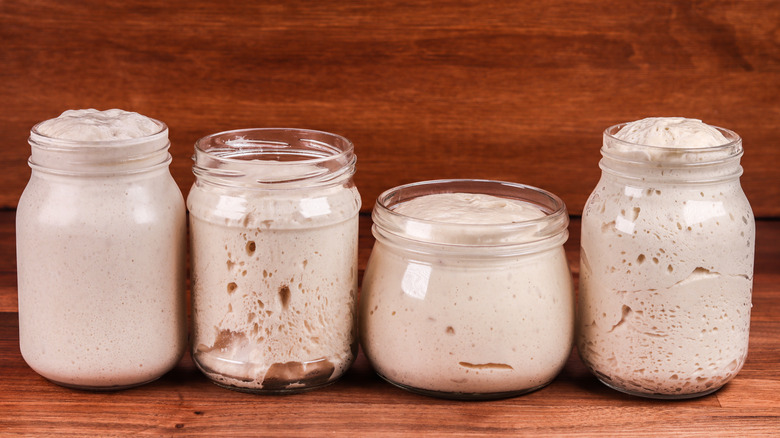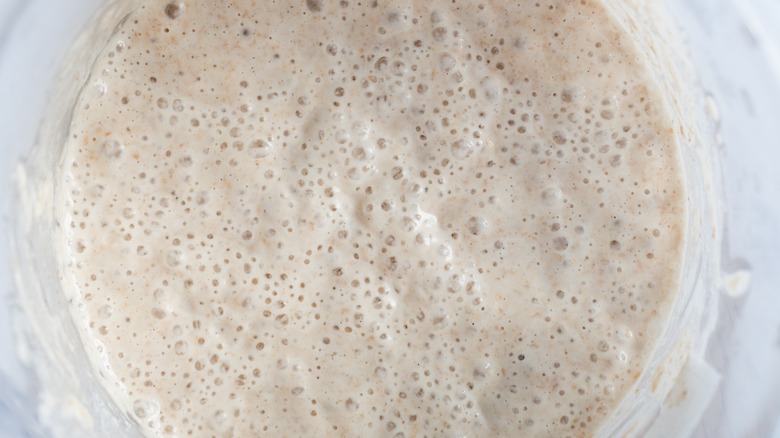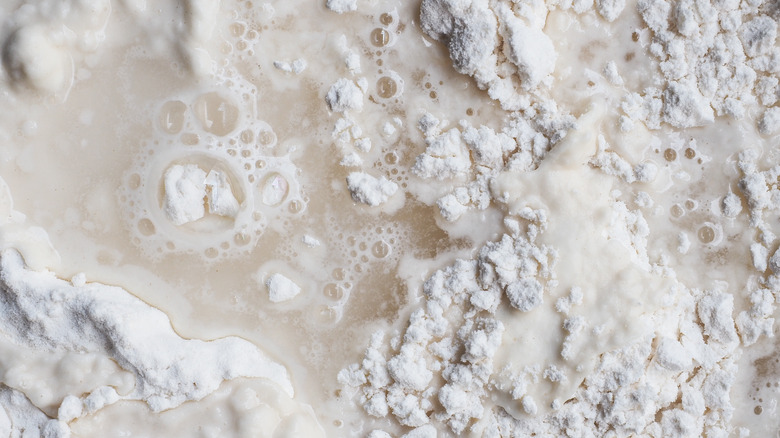Poolish, The Pre-Ferment That Pizzerias Use For Flavorful Dough
Pizza is often thought of as dinner in a hurry, calling to mind visions of an emergency freezer stash or frantic dialing of the local delivery number. But the truly good stuff, the Neapolitan-style pizza that's not just a quick comfort but a flavorful feast, takes a little more time to create. The secret ingredient to the perfect pizza dough is a type of pre-ferment known as poolish, and it needs time to develop that signature tangy taste.
A pre-ferment is a portion of dough that's allowed to ferment for hours before being added to the rest of the dough. Made with either sourdough culture or commercial yeast, water, and flour, this ticking flavor bomb develops tangy acids during its generous rest of anywhere from 8 to 24 hours. Poolish is a boon of flavor for almost every bread out there, from homemade bagels to oat porridge bread, but pizza dough is where it sees the most use.
Poolish not only improves the flavor of pizza dough, but it also helps create an incredible stretchy texture by strengthening the dough. So how does this meager amount of poolish pull off such a feat?
The Polish foundations of Poolish
As mentioned, pre-ferments are all about bringing sophisticated flavor and texture to the bread. With that in mind, it shouldn't surprise you to learn that certain kinds of pre-ferments, like sourdough starters, are as old as bread itself, being one of the most ancient parts of breadmaking. Poolish, on the other hand, is a relatively new pre-ferment on the block, as it can only trace its history back to the 19th century. Poolish was first developed in 1840 in Poland, by a nobleman and baker Baron Zang. The revolutionary mixture was later picked up by Austrian bakers, who used poolish as a flavorful shortcut in their baking processes. Finally, the Austrians brought it to France, where poolish quickly replaced the sourdough levain as the pre-ferment of choice.
While the original poolish was mostly used in pastry-making, these days it's more commonly associated with making the best-tasting baguettes, boules, and other bread products.
The essential ingredient of poolish
Though the ingredients are very simple — flour, water, and yeast — these can be combined in a number of ways that greatly affect what type of pre-ferment you end up with. In fact, pre-ferments are defined by hydration level and what type of yeast used. In the grand world of baking, hydration level refers to how much water is present in relation to the dry ingredients, where 100% hydration refers to when they are in equal parts. Hydration accelerates the fermentation process. For instance, the Italian pre-ferment biga has a lower hydration level than the Polish preferment of poolish, which means poolish ferments faster than biga.
With the yeast, everything is divided down the sourdough line, with starter and levain using wild yeast and all others using commercial yeast (the group poolish falls into). The amount of yeast used depends on two things: 1) how long you plan to ferment the poolish and 2) the temperature of the proving space. A cold space will require more yeast, a warm room less. This is, of course, what led to the refrigerator trick.
Speaking of time, think of it as the invisible fourth ingredient in your poolish. Most recipes recommend you ferment your poolish at room temperature from a range of 8 to 16 hours, with the length being dependent on yeast and room temperature. During that time, you should see it nearly double or triple in size, the pasty mixture becoming cobwebbed with air bubbles.
How and why to use poolish in your pizzas
There are several reasons poolish is the pre-ferment of choice for the king of all pies, Neapolitan pizza. First, poolish generally has 100% hydration, making it a particularly loose pre-ferment that gets bubbly and active faster than lower hydration ones. This is important as traditional pizza dough (made with delicate 00 flour) can't be proved as long as others and thus benefits from the quick method. Second, the added acidity of poolish helps strengthen the dough, an essential quality for a nice chewy pizza. Finally, Neapolitan pizza often opts for a poolish rather than a sourdough starter as the sourness of the starter can be overpowering, while commercial yeast-powered poolish offers the perfect amount of mildly sweet tang.
To add poolish to your own pizza dough, all you need to really do is plan ahead, as poolish requires some time and thus, forethought. Otherwise, it only requires three simple ingredients you already have on hand. So for a low-cost, high-reward kitchen project, consider using poolish as your secret weapon for your next pie.



